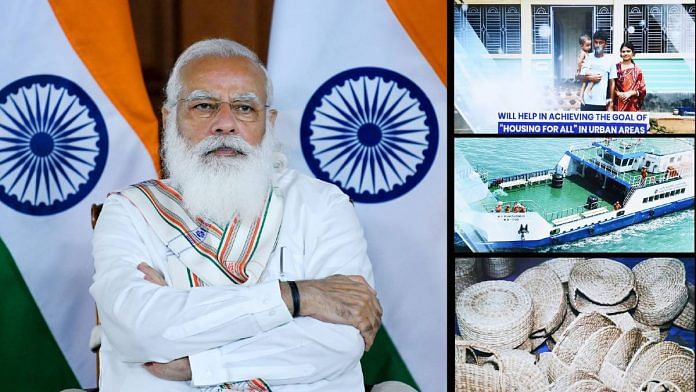New Delhi: Ahead of Prime Minister Narendra Modi’s much-awaited visit to Bangladesh on 26-27 March, India has given a massive push to enhance infrastructure connectivity with the neighbouring country, as New Delhi plans to take Dhaka into its strategic embrace under the umbrella of Indo-Pacific cooperation.
Dhaka will be Modi’s first trip abroad since the Covid-19 lockdown. Earlier this week, Modi and Bangladesh Prime Minister Sheikh Hasina virtually inaugurated the ‘Maitri Setu’, which will allow the landlocked Northeast easy access to the Chittagong Port of Bangladesh.
The 1.9-km bridge, built over the Feni River, will connect Tripura with Bangladesh. On the Indian side, it will connect with an integrated check post on the land border between Sabroom in India and Ramgarh in Bangladesh.
Apart from the Maitri Setu, or ‘Friendship Bridge’, India and Bangladesh are involved in a number of other initiatives that will prove to be the “projects of the future” when it comes to enhancing India’s ‘Neighbourhood Policy’ as well as ‘Look East Policy’, diplomatic sources told ThePrint.
These projects encompass water and shipping, railways, road and air links, all of which are aimed at taking the connectivity aspect to the “next level” and “assert larger influence” in the Bay of Bengal area, which is fast becoming the cornerstone of the Indo-Pacific strategy, the sources said.
While inaugurating the ‘Maitri Setu’, Modi said it is expected to “herald a new chapter” in India-Bangladesh ties, making Tripura the ‘Gateway of Northeast’, with the Chittagong Port located 80 km from the new integrated check post in Sabroom.
Added Hasina, “We are creating a new era in South Asia by providing connectivity to India. We are in a region which has remained conservative in opening up and where inter-regional trade is far below potential.”
Bangladesh has also allowed India to use its two most crucial ports — Chittagong and Mongla — for enhancing trade and people-to-people connectivity.
Connectivity projects that are high on the priority list are the Asian Highway Network routes (AH-1 and 2), which will be connecting India and Bangladesh at the Petrapole-Benapole, Fulbari-Banglabandha and Dawki-Tamabil points, and a new rail link between Akhaura (Bangladesh) and Agartala (India), among others.
“Robust infrastructure connectivity always has a strong strategic dimension to it because it is driven by economic cooperation and integration and thereby growth of an economy. Any kind of economic interdependence requires the existence of a basic infrastructure,” Constantino Xavier, Fellow at the think tank Centre for Social and Economic Progress, told ThePrint.
Xavier added, “There’s a huge demand in the region for export facilitation within the Indo-Pacific economies and so this bridge (Maitri Setu) is ultimately the ground zero for India’s Neighbourhood First Policy, Act East Policy and Indo-Pacific Policy.”
Also Read: Maitri Setu & why the India-Bangladesh bridge is being touted as ‘Gateway to Northeast’
Japan’s role in Bay of Bengal
While India and Bangladesh are jointly upping the game when it comes to building deeper connectivity in the region, the role played by Japan adds a significant dimension.
During the phone call between Modi and Japanese Prime Minister Yoshihide Suga Tuesday, days before the Quad Summit Friday, both leaders spoke about cooperation towards realising a “Free and Open Indo-Pacific”.
Tokyo is now collaborating with New Delhi in developing connectivity links with ASEAN (Association of Southeast Asian Nations) and the Far East region, which will, in the long run, boost economic and security aspects within the Quad grouping as far as maritime security is concerned, according to experts.
India and Japan, Xavier said, are now basically making an effort to revive the infrastructure that existed in the 1960s and “correcting a gap” — a push that will connect the entire landlocked northeast region of India with the Indo-Pacific and the rest of the world.
“This is the reason why Japan is also looking at this region and collaborating with India, Bangladesh and others, which ultimately will boost connectivity, growth and will also lessen China’s influence,” he added.
Former Indian envoy to Dhaka Veena Sikri said the Maitri Setu is a first-of-its kind project with bilateral, sub-regional and regional implications.
“This is one of the crucial projects for the Indo-Pacific, which is all about economics and security. And this is accentuated with the role being played by Japan within the Bay of Bengal area in partnership with India…” she said. “This bridge is going to provide India and Bangladesh greater access to Southeast Asia.”
Sikri believes that in the absence of SAARC (South Asia Association for Regional Cooperation, stalled on account of India-Pakistan tensions since the 2016 Uri terrorist attack), growing connectivity between India and Bangladesh will boost trade and business under the Bay of Bengal Initiative for Multi-Sectoral Technical and Economic Cooperation (BIMSTEC).
“So it’s a win-win for all… Bangladesh can now expect a lot of investments taking place, coming from the northeast, while it can source raw materials from there. South Asia is the least interconnected region and intraregional trade is abysmal compared to other regions of the world,” she said, adding that India and Japan are also collaborating on developing infrastructure in the northeast.
Bangladesh has made massive economic strides in recent years. Its GDP growth caught up with India’s in 2020, and the country is now set to exit the group of ‘Least-Developed Countries’ (LDC) by 2026.
Prime Minister Hasina, Sikri said, understands that in order to sustain this growth, she has to build a robust and enabling infrastructure.
Bangladesh sees the Indo-Pacific framework as an economic opportunity with the potential to boost the blue economy.
Also Read: From onions to vaccines — India promises to be a ‘true friend’ to Bangladesh



